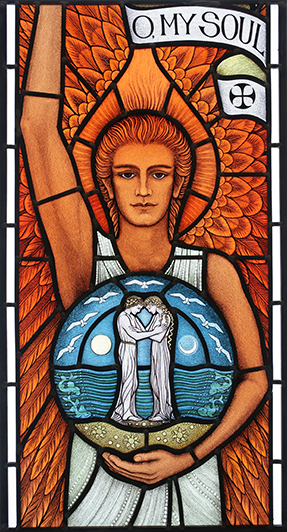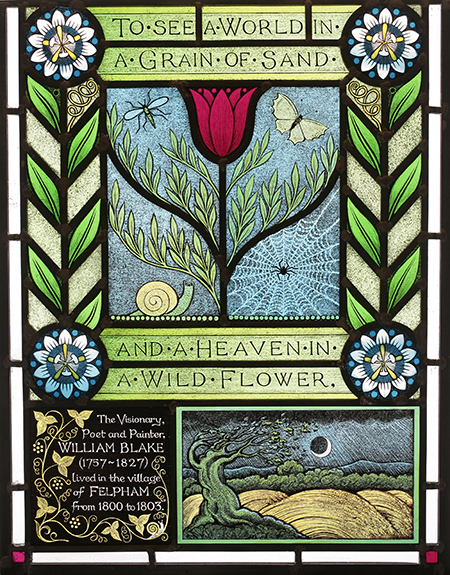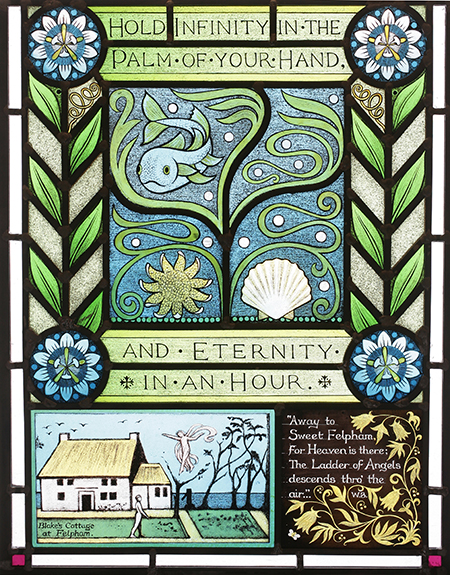The Blake Memorial Window in St. Mary’s Church, Felpham
Mark Crosby (crosbym@k-state.edu) is an assistant professor in the Department of English at Kansas State University. He is currently working on a monograph examining Blake’s various patronage relationships, and a catalogue of Blake’s apprenticeship work.

In 2011 a stained-glass window commemorating Blake’s three-year residence on the Sussex coast was consecrated in the parish church of St. Mary’s, Felpham. A Norman building dating to c. 1100, St. Mary’s is a short walk from the thatched cottage that Blake and Catherine occupied between 1800 and 1803. The Blake memorial window was commissioned by St. Mary’s parish council in 2007 and was funded by the generous contributions of Felpham parishioners and Blake enthusiasts and by donations raised through local charitable events celebrating the 250th anniversary of Blake’s birth. The window was designed by the artist Meg Lawrence, whose work also includes painting with an egg-based tempera medium on wood panels, a medium similar to the one that Blake used, with animal glue and gum Arabic as the binding agents instead of egg, for some of his 1799 illustrations of the Bible.For more information on Lawrence’s painting techniques, see <http://www.radnorshire.com/introduction.html>. For Blake’s tempera, see William Blake: The Painter at Work, ed. Joyce H. Townsend (London: Tate Publishing, 2003) 113-14.
An experienced stained-glass artist and conservator, Lawrence has designed many windows for parish churches throughout England and Ireland. They are made using entirely traditional materials and techniques of painting and manufacture. Of crucial importance is the use of mouth-blown glass of the highest possible quality, made at a small factory in Bavaria. Much of the glass that she works with is blown to her own specification, giving exactly the colors and graduated tones required. She also employs flashed glass, which adds a very thin layer of colored glass over a thicker layer, thereby giving the opportunity to manipulate the colors further by the use of acid etching. Colored glass, cut for the window, is painted and fired in the kiln up to three times to build up layers of drawing, shading, pattern, and texture. The windows are assembled using lead cames. One of her painting techniques is the use of linear brush-strokes, a method of draftsmanship that Blake famously champions in his Descriptive Catalogue: “The great and golden rule of art, as well as of life, is this: That the more distinct, sharp, and wirey the bounding line, the more perfect the work of art” (E 550).
Lawrence’s overall design combines figurative Christian iconography with recognizable Blakean motifs and centers on two male figures with halo-like auras and feathered wings. These are angels of creation rising from the sea to the heavens (illus. 1 and 2).


Beneath the angels are self-contained pictures, known as predellas (illus. 3 and 4).


Either side of the lower predellas are decorative panels containing twisting vines and blooming flowers that evoke the interlinear designs of Blake’s illuminated books. The panel next to the image of Blake’s cottage includes the following verse from Catherine Blake’s letter to Ann Flaxman of 14 September 1800: “Away to Sweet Felpham for Heaven is there / The Ladder of Angels descends thro the air” (E 709). The panel buttressing the image of Blake’s Virgil woodcut bears the legend: “The Visionary, Poet and Painter, William Blake (1757-1827) lived in the village of Felpham from 1800 to 1803.”
It is not known if the Blakes attended St. Mary’s during their residence on the south coast, although Blake did include the church tower in his unfinished watercolor Landscape near Felpham (c. 1800; Butlin 368). The window is located in the south chancel wall, overlooking the area where couples exchange marriage vows. It was installed in late 2010 and dedicated by the dean of Chichester in May 2011.
Acknowledgments
I am indebted to Mrs. Heather Howell, current resident of Blake’s cottage in Felpham, and Meg Lawrence for help in preparing this minute particular.